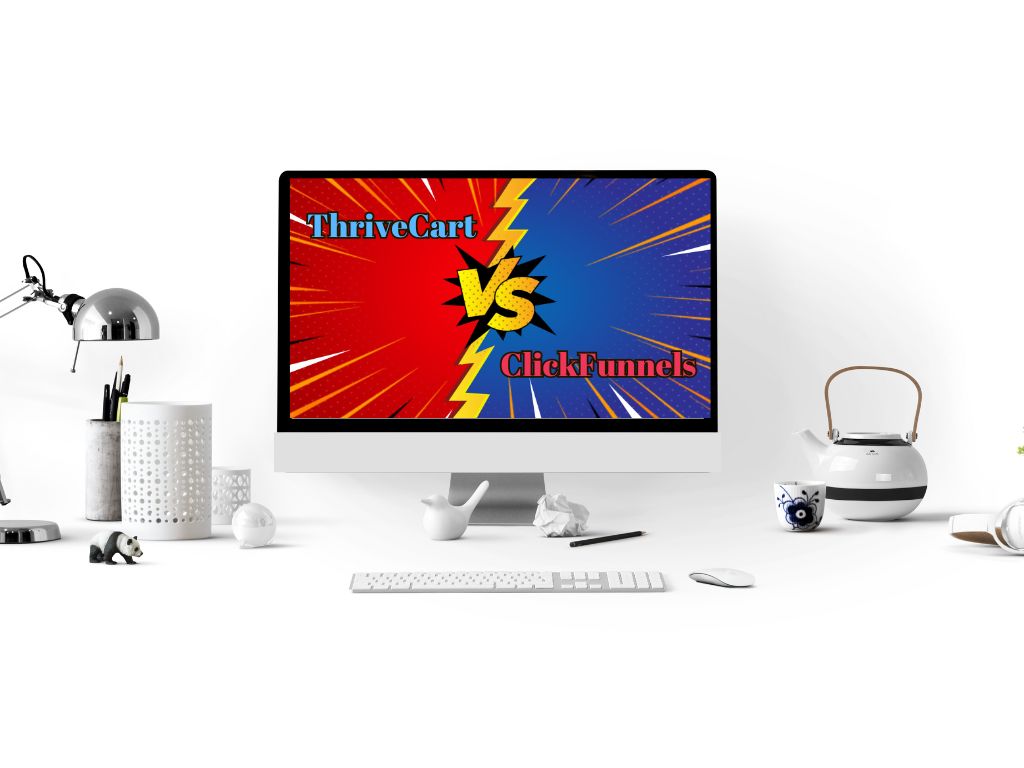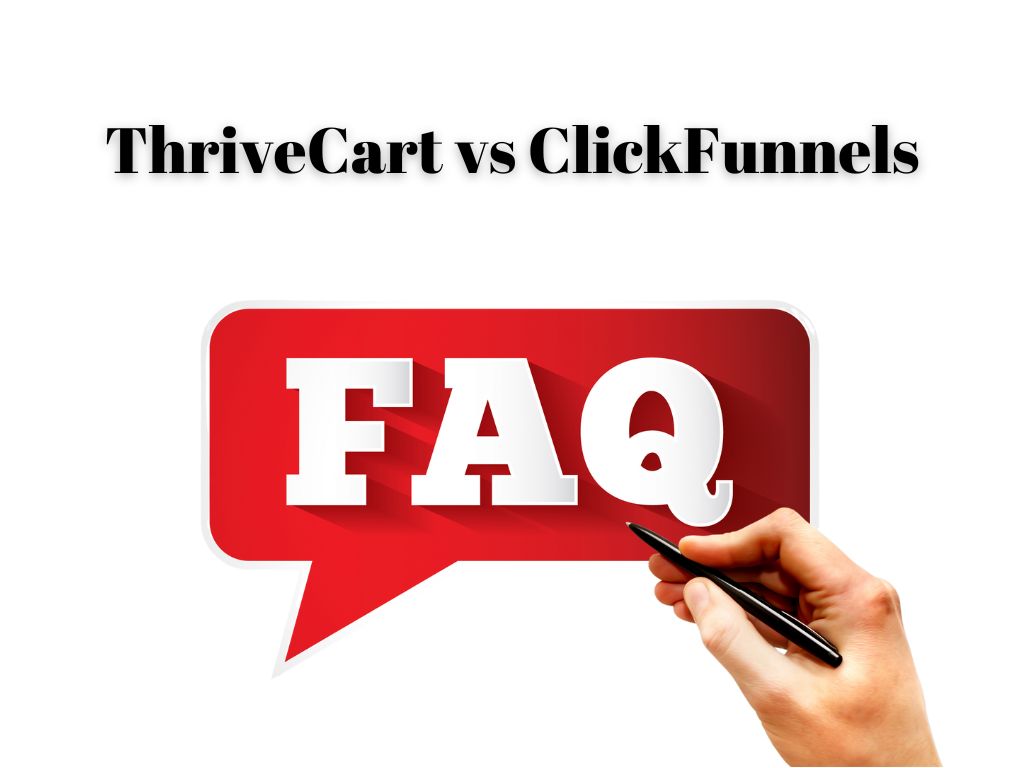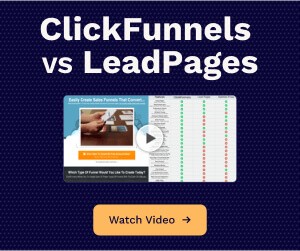Introduction
ThriveCart vs ClickFunnels isn’t just a comparison of tools, it’s a choice between two different ways of selling online.
ThriveCart is built to optimize the final step: the checkout. It’s focused on helping you convert warm prospects into buyers with high-performing cart pages, upsells, and affiliate tracking all centered around one goal: getting paid.
ClickFunnels is designed to manage everything before that moment. From opt-in pages and lead magnets to webinars, sales pages, and follow-up funnels, it gives you the tools to build a full conversion journey from first click to final sale.
Both platforms can help you grow revenue. But they don’t solve the same problem.
This guide compares ClickFunnels and ThriveCart side by side focusing on features, checkout tools, funnel capabilities, pricing, and which one better fits how you sell. If you’re deciding between the two, this breakdown will help you choose the smarter path for your business.

ThriveCart vs ClickFunnels: What These Platforms Are Built to Do
ClickFunnels and ThriveCart both help you sell but they’re built to handle different parts of the sales process.
ClickFunnels is a funnel-building platform. Its core focus is on guiding cold traffic through a series of steps: opt-in, sales page, order form, upsell, confirmation. It’s ideal for marketers and creators who need full control over the sales experience from the first click to the final purchase.
Every feature is built around one idea: increase conversion through guided storytelling.
ThriveCart is a checkout optimization platform. It focuses on the tail end of the buyer journey: the transaction. You bring the traffic and sales pitch ThriveCart handles the checkout flow, upsells, and product delivery.
It’s fast, lightweight, and designed to improve how you close the sale, not how you build up to it.
Here’s the core difference:
- ClickFunnels helps you create a sales path.
- ThriveCart helps you finish it effectively.
If your business revolves around lead generation, webinars, product launches, or storytelling funnels ClickFunnels gives you the tools to build that system. If your focus is on optimizing conversions at the point of purchase ThriveCart is built to tighten that final moment.
ThriveCart vs ClickFunnels: Sales Funnels
This is where the contrast between ClickFunnels and ThriveCart becomes obvious one is built around the funnel, the other supports it at the end.
ClickFunnels gives you a full funnel-building environment. You can map out multi-step sales flows with opt-in pages, landing pages, sales videos, order forms, upsells, downsells, and thank-you pages all connected inside a visual editor.
You control the user journey from first touchpoint to final sale. It’s not just a cart, it’s the entire marketing system.
ThriveCart, on the other hand, isn’t built to create funnels, t’s built to plug into them. It offers simple upsell and downsell paths that appear after the initial checkout step.
You can create a streamlined flow of product → bump → upsell → thank you, but you won’t be building full pre-sale pages, lead capture flows, or front-end funnels within ThriveCart.
Quick comparison:
- ClickFunnels = Build the funnel from scratch, step by step
- ThriveCart = Optimize the end of the funnel once they’re ready to buy
If your strategy starts with traffic generation and lead nurturing, ClickFunnels gives you the infrastructure to guide the entire journey. If you’ve already got the journey built and just need a faster, cleaner way to convert ThriveCart is the better finishing tool.

ThriveCart vs ClickFunnels: Checkout Experience
This is where ThriveCart shines and where ClickFunnels shows its limits.
ThriveCart is purpose-built to optimize the checkout process. It offers high-converting cart templates, one-page and multi-step checkout options, bump offers, one-click upsells, and full control over payment settings.
You can customize everything from the layout to the fields to the behavior after purchase. The focus is on reducing friction and boosting average order value at the moment of transaction.
ClickFunnels includes a functional checkout page as part of its funnel builder, but it’s more limited in scope. You can add product details, payment buttons, and upsells, but the customization options are narrower.
There’s no dedicated cart logic like multiple payment types, detailed tax controls, or native sales tax/VAT handling.
The real difference:
- ThriveCart treats checkout as a core product.
- ClickFunnels treats it as one step in the funnel.
If your business relies on maximizing conversions at checkout especially with digital products, subscriptions, or payment flexibility ThriveCart gives you deeper control.
If your focus is on owning the full user journey, and the checkout is just part of that flow, ClickFunnels still fits but with less optimization at the point of sale.

ThriveCart vs ClickFunnels: Digital Product Delivery
Selling is only half the equation how you deliver your product matters just as much, especially in the digital space.
ThriveCart includes native tools for delivering digital products. Once someone completes a purchase, you can automatically redirect them to a file download, a custom URL, or a course platform.
More recently, ThriveCart launched Thrive Learn, its built-in learning management system (LMS).
This allows you to create and deliver courses, track user progress, manage access levels, and eliminate the need for a third-party LMS in many cases.
ClickFunnels also includes basic digital delivery options through its membership site feature. You can create gated content areas for buyers, organize lessons by section, and drip content over time.
However, the membership system is more limited in design flexibility and user tracking compared to standalone LMS platforms.
Many ClickFunnels users end up integrating with Teachable, Kajabi, or similar tools for a more complete learning experience.
The key difference:
- ThriveCart focuses on transaction-based delivery clean, simple, effective.
- ClickFunnels focuses on funnel-connected membership access great for nurturing ongoing engagement, but with less depth for course structure.
If you want a lightweight, built-in way to deliver courses or content after a purchase, ThriveCart + Thrive Learn covers most use cases.
If your goal is to tie your delivery into a broader funnel or upsell structure, ClickFunnels gives you more control over the journey but fewer tools for the content itself.

ThriveCart vs ClickFunnels: Affiliate Management
Both ClickFunnels and ThriveCart offer affiliate features but the depth, cost, and usability vary significantly.
ThriveCart includes a robust affiliate management system out of the box, with no extra cost. You can create custom commission structures, set approval requirements, offer lifetime commissions, manage affiliate links, and track detailed performance metrics.
It also supports multiple payout methods, affiliate tagging, and bonuses all through a simple dashboard.
ClickFunnels, on the other hand, offers affiliate tools via Backpack, which is only available on higher-tier plans (Funnel Hacker or similar).
It allows you to set up affiliate programs, assign commissions, and manage users but it’s not as intuitive or feature-rich as ThriveCart’s affiliate engine. It works best for simple setups, not advanced affiliate structures.
Where they differ:
- ThriveCart treats affiliate management as a native, integrated feature easy to set up and ready for real campaigns.
- ClickFunnels offers affiliate tools, but only if you pay more and they’re less flexible overall.
If you plan to scale with affiliates and want full control without upgrading your plan, ThriveCart is the stronger platform.
If you’re already using ClickFunnels for your funnel and only need basic affiliate tracking, Backpack may be enough but comes at a premium.

ThriveCart vs ClickFunnels: Integrations
When it comes to connecting with external tools email services, CRMs, payment gateways, webinar platforms both ClickFunnels and ThriveCart offer integration options, but the approach and flexibility are different.
ThriveCart supports integrations with most major platforms, including:
- Email marketing tools like ActiveCampaign, ConvertKit, Mailchimp, and Drip
- Payment processors like Stripe, PayPal, and Apple Pay
- Membership tools, webinar platforms, and fulfillment systems
- Deep Zapier support for extended automation and custom workflows
The setup is clean, and you can assign integrations per product, giving you granular control over what happens after a sale.
ClickFunnels also integrates with popular tools, particularly:
- Email platforms (ActiveCampaign, GetResponse, Mailchimp, etc.)
- Stripe, PayPal, and custom payment gateways
- Webinar tools, membership platforms, and CRMs
- Zapier, plus native APIs for custom solutions
ClickFunnels relies heavily on integrations for email automation (unless you’re on higher plans with Follow-Up Funnels), and it handles them through its built-in settings at the funnel or page level.
The difference in approach:
- ThriveCart uses integrations to enhance your checkout and delivery systems
- ClickFunnels uses integrations to extend your funnel-building and follow-up marketing
If you need tight control over what happens after a transaction, ThriveCart’s integration flow is cleaner and more product-specific.
If you need to connect tools across an entire funnel including lead capture, automation, and retargeting ClickFunnels offers more flexibility in marketing logic.

ThriveCart vs ClickFunnels: Ease of Use & Setup
Both ClickFunnels and ThriveCart aim to simplify the online selling process but they simplify different things.
ThriveCart is built for speed and clarity. The setup process is straightforward: add a product, set pricing, connect your payment gateway, customize your checkout, and go live.
There’s no drag-and-drop builder for entire funnels, but everything related to the transaction process is fast and intuitive.
You don’t need design skills or advanced configuration to launch a clean, high-converting checkout.
ClickFunnels offers more power, but with more moving parts. Building a full funnel involves setting up each page opt-in, sales, checkout, thank you linking them together, adjusting design, and managing automation rules.
It’s still user-friendly compared to coding a funnel from scratch, but it takes longer to launch and has a steeper learning curve, especially if you’re new to funnel-building.
The key difference:
- ThriveCart is easier to set up if you just need a clean cart, fast.
- ClickFunnels gives you more control, but requires more upfront work and structure.
If your goal is to start selling quickly with minimal setup, ThriveCart is faster out of the box.
If you’re building multi-step funnels with branding, logic, and lead capture, ClickFunnels offers more but it’s a longer ramp-up.

Pricing Breakdown: ThriveCart vs ClickFunnels
ThriveCart Pricing
ThriveCart stands out for its one-time pricing model a major appeal for solopreneurs, course creators, and digital product sellers.
- One-time payment (lifetime access, if the offer is still available)
- Includes cart builder, upsells, bump offers, affiliate management, and basic digital delivery
- Optional ThriveCart Pro upgrade (adds advanced affiliate tools, sales tax handling, subscription management, and more)
Once you buy ThriveCart, you own it no monthly fees. That makes it one of the most cost-effective tools for checkout-focused sales models.
ClickFunnels Pricing
ClickFunnels follows a monthly subscription model, with multiple tiers based on features and usage:
- Basic Plan: Funnel builder, basic pages, limited integrations
- Pro Plan / Funnel Hacker: Adds email marketing (Follow-Up Funnels), affiliate management (Backpack), analytics, and more
- Pricing increases as you unlock advanced tools or need higher limits
While ClickFunnels gives you more in terms of funnel strategy and full sales flow creation, it comes with a recurring cost and some of the most valuable features are locked behind higher-tier plans.
Which Offers Better Long-Term Value?
- ThriveCart offers better value if your priority is checkout performance and you want to avoid ongoing software expenses.
- ClickFunnels delivers stronger ROI if you rely on complete funnel strategies, lead generation, and full customer journeys.
If your sales model is simple and product-focused, ThriveCart keeps your overhead low. If your model is funnel-heavy and conversion-driven, ClickFunnels can pay off if you fully use its features.

Which Platform Fits the Way You Sell?
Choosing between ThriveCart and ClickFunnels isn’t just about features, it’s about how your business makes money.
Choose ThriveCart If You’re Focused on Selling Products Not Building Funnels
If your business already has traffic, and you just need a fast, optimized way to collect payments and deliver products, ThriveCart does that better than almost anything else. It’s ideal for:
- Course creators who don’t need complex lead funnels
- Digital product sellers who want one-click upsells and fast checkouts
- Businesses focused on improving checkout conversion and AOV
- Sellers who want strong affiliate tools without paying monthly
It’s simple, lean, and efficient. If your priority is getting paid cleanly, ThriveCart is hard to beat.
Choose ClickFunnels If Your Sales Rely on Funnel Strategy
If your success depends on guiding cold traffic through a multi-step journey from awareness to offer to upsell, ClickFunnels is built for that exact model. It’s ideal for:
- Marketers who need to generate and nurture leads
- Coaches, consultants, or info sellers who rely on webinars and launches
- High-ticket offers that need structured storytelling and trust-building
- Entrepreneurs who want to build, test, and optimize funnels at scale
If your priority is controlling the entire customer journey, ClickFunnels gives you the infrastructure to do it.
In short:
- Use ThriveCart when your offer is ready, and you just need to sell it.
- Use ClickFunnels when your offer needs a journey before the sale happens.

ThriveCart vs ClickFunnels: Pros and Cons
ThriveCart Pros and Cons
Pros
- One-time payment (no ongoing monthly fees)
- High-converting checkout templates
- Built-in upsells, downsells, and bump offers
- Powerful affiliate management included
- Fast setup and easy to use
- Integrated course delivery via Thrive Learn
Cons
- No funnel or landing page builder
- Limited lead generation features
- Less control over the pre-sale customer journey
- Design flexibility is limited compared to full-page builders
ClickFunnels Pros and Cons
Pros
- Full funnel builder with visual editor
- Optimized for multi-step sales journeys
- Includes landing pages, lead capture, upsells, and follow-ups
- Membership and course delivery features available
- Built-in email automation (on higher plans)
Cons
- Recurring monthly cost, especially for full feature access
- Checkout features are basic compared to ThriveCart
- Affiliate management only available on premium plans
- Longer setup and steeper learning curve
Quick Comparison Table
| Feature | ThriveCart | ClickFunnels |
| Funnel Builder | No | Yes |
| Checkout Optimization | Yes (core focus) | Basic |
| Affiliate Management | Included | Premium plan only |
| Email Automation | No native email | Available on higher tiers |
| Digital Product Delivery | Yes (via Thrive Learn) | Yes (via Membership Sites) |
| Pricing Model | One-time payment | Monthly subscription |
| Best For | Checkout-focused sellers | Funnel-based marketers |

Frequently Asked Questions (FAQs)
Can I use ThriveCart and ClickFunnels together?
Yes. Many marketers use ClickFunnels to build the funnel and ThriveCart to handle the checkout. You can link from a ClickFunnels sales page directly to a ThriveCart checkout for better cart performance and affiliate tracking.
Does ThriveCart replace the need for a funnel builder?
No. ThriveCart is a checkout and cart tool not a funnel builder. It’s great for managing the final transaction and delivery, but you’ll need to create your landing pages and funnel elsewhere.
Does ClickFunnels have built-in checkout tools?
Yes, but they’re basic. ClickFunnels supports payments, order forms, and upsells, but it lacks the deep cart customization and flexibility ThriveCart provides. If you’re focused on checkout performance, ThriveCart is stronger.
Is ThriveCart still a one-time payment?
As of now, ThriveCart offers lifetime access for a single payment. However, this offer may not last forever, and they’ve indicated plans for a subscription model in the future.
Which platform offers better affiliate management tools?
ThriveCart has more robust affiliate tools built in at no extra cost. ClickFunnels offers affiliate features (Backpack), but only on higher-tier plans and with fewer customization options.

Conclusion
ThriveCart and ClickFunnels aren’t competing for the same role in your business, they’re solving different problems.
ThriveCart is built to optimize the moment of purchase. It’s simple, powerful, and ideal for creators, digital product sellers, and anyone who wants to streamline checkout and increase average order value. If your funnel is already in place or you don’t need one ThriveCart offers exceptional value, especially with its one-time pricing.
ClickFunnels is built to manage the entire sales journey. If you need to capture leads, warm them up, present an offer, and build structured campaigns that convert cold traffic into customers, ClickFunnels is the better fit. It costs more, but it gives you a complete marketing system.
Choose ThriveCart if:
- You already have traffic or an audience
- You’re focused on checkout performance and delivery
- You want to avoid ongoing software costs
Choose ClickFunnels if:
- You need a full funnel from landing page to offer to follow-up
- Your sales depend on storytelling, sequencing, and strategy
- You’re running multi-step campaigns and high-ticket funnels
In short: ThriveCart sells what’s ready to buy. ClickFunnels builds the path to get there.
Pick the platform that fits your process not just your budget.
For a leaner lead-gen focus, this ClickFunnels vs Leadpages guide is a must-read.
1 Comment
ClickFunnels vs SamCart: Which One Actually Sells Better? - Ismel Guerrero. · April 19, 2025 at 2:25 pm
[…] may want to read this next: ThriveCart vs ClickFunnels — a closer look at two conversion-focused platforms built for selling […]